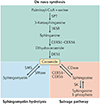Ceramides and other sphingolipids as drivers of cardiovascular disease
- PMID: 33772258
- PMCID: PMC8978615
- DOI: 10.1038/s41569-021-00536-1
Ceramides and other sphingolipids as drivers of cardiovascular disease
Abstract
Increases in calorie consumption and sedentary lifestyles are fuelling a global pandemic of cardiometabolic diseases, including coronary artery disease, diabetes mellitus, cardiomyopathy and heart failure. These lifestyle factors, when combined with genetic predispositions, increase the levels of circulating lipids, which can accumulate in non-adipose tissues, including blood vessel walls and the heart. The metabolism of these lipids produces bioactive intermediates that disrupt cellular function and survival. A compelling body of evidence suggests that sphingolipids, such as ceramides, account for much of the tissue damage in these cardiometabolic diseases. In humans, serum ceramide levels are proving to be accurate biomarkers of adverse cardiovascular disease outcomes. In mice and rats, pharmacological inhibition or depletion of enzymes driving de novo ceramide synthesis prevents the development of diabetes, atherosclerosis, hypertension and heart failure. In cultured cells and isolated tissues, ceramides perturb mitochondrial function, block fuel usage, disrupt vasodilatation and promote apoptosis. In this Review, we discuss the body of literature suggesting that ceramides are drivers - and not merely passengers - on the road to cardiovascular disease. Moreover, we explore the feasibility of therapeutic strategies to lower ceramide levels to improve cardiovascular health.
© 2021. Springer Nature Limited.
Figures




Similar articles
-
Ceramide Metabolism in Cardiovascular Disease: A Network With High Therapeutic Potential.Arterioscler Thromb Vasc Biol. 2022 Oct;42(10):1220-1228. doi: 10.1161/ATVBAHA.122.318048. Epub 2022 Aug 25. Arterioscler Thromb Vasc Biol. 2022. PMID: 36004640 Review.
-
You aren't IMMUNE to the ceramides that accumulate in cardiometabolic disease.Biochim Biophys Acta Mol Cell Biol Lipids. 2022 Jun;1867(6):159125. doi: 10.1016/j.bbalip.2022.159125. Epub 2022 Feb 23. Biochim Biophys Acta Mol Cell Biol Lipids. 2022. PMID: 35218934 Free PMC article.
-
The Dark Side of Sphingolipids: Searching for Potential Cardiovascular Biomarkers.Biomolecules. 2023 Jan 13;13(1):168. doi: 10.3390/biom13010168. Biomolecules. 2023. PMID: 36671552 Free PMC article. Review.
-
Ceramides - Lipotoxic Inducers of Metabolic Disorders.Trends Endocrinol Metab. 2015 Oct;26(10):538-550. doi: 10.1016/j.tem.2015.07.006. Trends Endocrinol Metab. 2015. PMID: 26412155 Review.
-
Involvement of Ceramides in Non-Alcoholic Fatty Liver Disease (NAFLD) Atherosclerosis (ATS) Development: Mechanisms and Therapeutic Targets.Diagnostics (Basel). 2021 Nov 5;11(11):2053. doi: 10.3390/diagnostics11112053. Diagnostics (Basel). 2021. PMID: 34829402 Free PMC article. Review.
Cited by
-
Regulation of serine palmitoyl-transferase and Rac1-Nox2 signaling in diabetic retinopathy.Sci Rep. 2022 Oct 6;12(1):16740. doi: 10.1038/s41598-022-20243-2. Sci Rep. 2022. PMID: 36202842 Free PMC article.
-
Effects of scutellarin on the mechanism of cardiovascular diseases: a review.Front Pharmacol. 2024 Jan 8;14:1329969. doi: 10.3389/fphar.2023.1329969. eCollection 2023. Front Pharmacol. 2024. PMID: 38259289 Free PMC article. Review.
-
Sphingosine-1-phosphate controls endothelial sphingolipid homeostasis via ORMDL.EMBO Rep. 2023 Jan 9;24(1):e54689. doi: 10.15252/embr.202254689. Epub 2022 Nov 21. EMBO Rep. 2023. PMID: 36408842 Free PMC article.
-
Platelet-Derived S1P and Its Relevance for the Communication with Immune Cells in Multiple Human Diseases.Int J Mol Sci. 2022 Sep 7;23(18):10278. doi: 10.3390/ijms231810278. Int J Mol Sci. 2022. PMID: 36142188 Free PMC article. Review.
-
Metabolomic Profile Reveals That Ceramide Metabolic Disturbance Plays an Important Role in Thoracic Aortic Dissection.Front Cardiovasc Med. 2022 Feb 8;9:826861. doi: 10.3389/fcvm.2022.826861. eCollection 2022. Front Cardiovasc Med. 2022. PMID: 35211530 Free PMC article.
References
-
- Hales CM, Carroll MD, Fryar CD & Ogden CL Prevalence of obesity and severe obesity among adults: United States, 2017–2018. NCHS Data Brief, no. 360 (National Center for Health Statistics, 2020). - PubMed
Publication types
MeSH terms
Substances
Grants and funding
LinkOut - more resources
Full Text Sources
Other Literature Sources
Medical

